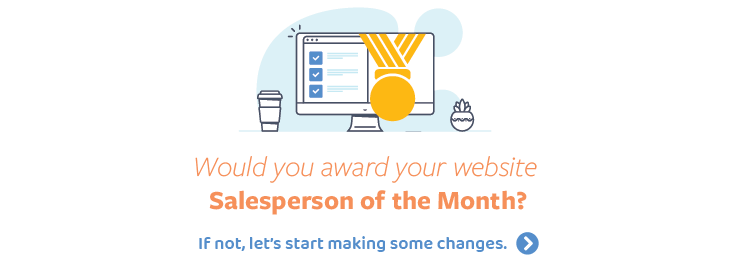Everyone seems to be talking about how to create leads in another year of zoom meetings, unanswered office phones and fewer face to face sales opportunities. Literally, what can you do to be sure you get the leads you need?
There's always the option of running digital ads. These can be pricey depending on your product or service and the competition for it. While you might not be able to avoid running ads, your website needs to provide the information that people are looking for if they click on your ad.
What about if they're searching for an answer to a problem they're having. Is your website going to show up with the solution or at least an introduction to a solution? Here's where inbound marketing can become a lead generation system that brings you leads who you can really help... if nurtured correctly.
But, inbound marketing is not for everyone. How do you know if you should be using this as one of your primary lead generation tools?
What Is Inbound Marketing?
First, let's take a moment to define inbound marketing and how it impacts the sales process. Digital marketing leader HubSpot defines inbound marketing as a "business methodology that attracts customers by creating valuable content and experiences tailored to them." Examples of inbound marketing strategies include publishing content like blogs, eBooks, and videos as well as launching social media marketing campaigns, and optimizing your website text for search engines using effective SEO.
Inbound vs. Outbound Marketing
It's also important to understand the difference between inbound and outbound marketing. HubSpot defines outbound marketing as "a traditional method of marketing seeking to obstruct potential customers. Outbound marketing includes activities such as trade shows, seminar series, and cold calling." There's a place and time for these approaches to generating leads. But for now, in a COVID world, these are harder to accomplish with any significant rate of success.
So... if you're going to need to rely on your website for bringing the leads to you, here are some things to consider about whether inbound marketing is a good option.
5 Stages of the Purchasing Decision Process
Now that you've gained a basic understanding of what inbound and outbound marketing is and the differences between them, let's go over the five stages of the purchasing decision process and begin to tie that in with an effective inbound strategy.
Most buyers, whether they're B2B or B2C follow the same thought process when they approach a buying decision:
- Awareness: In this stage, targeted buyers become aware of how you can solve a problem or meet a need they have. In some cases, inbound marketing strategies can allow your company to help identify the problem for them.
- Consideration: Once a need or problem has been established and buyers are aware that your product or service may help them, they'll begin to consider how. This process typically includes looking at other options, including your competitors' products and services.
- Preference/Intent: As buyers consider their available options, they will start to form opinions based on what they've learned and who they've grown to trust. About 60% of the purchasing decision process is completed before a buyer ever speaks to someone at your company. Usually, the buyer is fairly confident about their decision by the time they reach this stage.
- Purchase: At last the buyer makes a purchase. This may be a complex process with contracts and clauses, or it can be a simple transaction that can be done online, depending on the types of goods or services you offer.
- Repurchase: Once the buyer begins to use your product or service, an emotional and logical process occurs that creates loyalty to your company that will ideally lead to repeat purchases.
How Much Time Does It Take For a Buyer to Make a Decision?
How long does the purchase process listed above take for the product or service you're selling?
Steps 1-4 above can take a few minutes, a few weeks or a few months depending on what it is, how many alternatives there are, and the individual's personal style when making decisions.
If the answer is less than a day, you wouldn't have time to collect a lead through the website and then nurture them through the sales process. This means that your inbound marketing strategies may not be as effective in these situations.
There are scenarios in which a potential customer simply doesn't have time to do much research into who will provide the product or service they need. For example, if their heater suddenly stops working or they need to go to the emergency room. For these types of decisions, people are more likely to rely on personal references, online reviews, and coupons so they can act quickly.
This doesn't mean that inbound marketing can't work for companies whose target market likely needs to make their purchasing decisions as quickly as possible. It just means that the process of building a relationship with potential customers through content and lead nurturing would need to focus on specific decisions that most people don't make overnight.
B2B vs. B2C Purchasing Decisions
Let's take a moment to examine the decision-making process from a B2B perspective and compare it to the B2C process outlined above. Many companies assume that lead generation and inbound marketing for B2B customers are radically different from marketing for B2C, however, it's important to remember that there are humans on the end of both of those processes. Call it H2H -- Human to Human.
And because people are people, the approach is very similar when there is a longer decision process before the purchase.
I recommend that marketers always pay attention to the time it typically takes for a target customer to make a buying decision on your product or service. This allows you to get a better feel for whether or not inbound marketing is a good fit for your business model and if so, what kind of inbound process you need to create.
Inbound Marketing by Time to Make Decision
One Week to One Month to Make a purchase Decision
In general these decisions may take less persuasion and tend to be somewhat lower in price. That means you should not spend as much to get the customer compared to a longer decision process.
Consider including strategies that are able to quickly nurture potential customers prior to their buying decision, as well as creating a plan to immediately begin nurturing the repurchase process.
- Social media marketing. Social media marketing is one of the most powerful types of advertising available now because it offers both affordability and extremely granular audience targeting. For example, if you place a Facebook ad for just a few dollars a day, you can set it to display to people in a certain geographical area who make a certain amount of money and have particular interests that you've identified. Once your ads are launched, users in your target area will start seeing your content right away in their news feeds.
- Pay-Per-Click advertising. Pay-Per-Click marketing, or PPC, is typically more expensive than other types of marketing, especially for certain markets like legal and medical. However, it's also the fastest way to get found for target keywords that your audience is using to look for solutions to their problems. The content on your website is really important though. Try to avoid landing pages with very little information on the topic of the ad. Google likes to see that the page you're sending people to is highly correlated to the content of the ad. That's why ongoing content updating is important, even when you're running third-party ads.
- Remarketing. Once someone has visited your website to look around, make sure you retarget them with another ad in a sequence that will help them down a decision path.
More than a Month to Make a Purchase Decision
If it takes your target audience longer than a month to make a buying decision, you should have an ongoing drip of helpful content that you can slowly feed to potential customers over the course of a longer period of time. Your website should have engaging, rich content that caters to potential customers at every stage of the buyer's process.
- Blogging. Producing regular blog content that answers questions and engages readers is a long-term strategy to educate potential buyers that also helps increase your SEO by showing search engines that your website is regularly updated with rich content.
- Pillar Pages. When you have a few important topics for visitors, and you've built up content over time to explain it, you should organize it in a pillar format. The main, overarching topic is the "pillar" with sub pages on the topic connected to the pillar.

- Guest Posting. Guest posting, or guest blogging, on another company or organization's website is a good way to increase your brand exposure beyond your own we properties. Be sure any guest posting gives you credit and links to your website where they can get more information. This a great addition to other inbound marketing tactics, but isn't powerful enough to stand on its own.
- Webinars. With fewer live opportunities to meet with people and present information, using live and/or recorded webinars to provide the information can really help people with learning more on a topic and progressing their decision process. For these be sure you're using social media to promote it and even ads to your target audience.
You should also use social posts and, when needed, digital ads to support the decision process.
Consider using marketing software like HubSpot to reduce the amount of work you have to put in to attract website visitors, convert casual browsers into leads, and then nurture them throughout the sales process. Lead generation becomes much easier to manage and monitor when you use inbound marketing software and it helps you keep track of the ROI of your marketing investments. You'll be able to quickly identify lead generation tactics that aren't working so you can funnel your efforts and advertising dollars into tactics that do.Remember... humans make purchasing decisions in a very similar way regardless of what product or service they're interested in and whether they're making the purchase as a consumer or business representative. By understanding how people move through the sales process -- and how quickly they do so -- can help you tailor your inbound marketing strategies to be as effective as possible.
Inbound marketing is one of the most effective ways to generate quality leads. However, inbound isn't one-size-fits-all. An inbound marketing strategy for business-to-consumer (B2C) products and services may not be the same as inbound marketing for business-to-business (B2B) products and services.
That said, regardless of whether a purchase is for personal use or for company use, a human is making the decision. How much time does it take for them to make a buying decision and how does this integrate into a comprehensive inbound marketing strategy?
Originally published May 2016. Revised December 2020.
December 9, 2020





